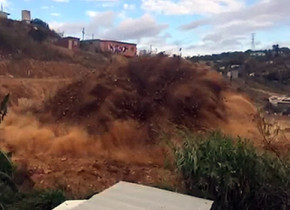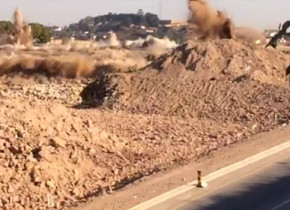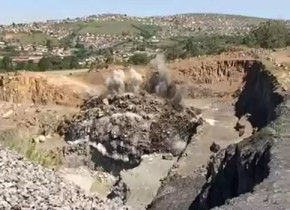Safety is paramount!
To Surface Blasting Services, safety is paramount at all times.
That’s why we not only observe the strictest of safety regulations, but use a sensitive vibro recorder to monitor every blast in close proximity of structures. With this equipment, we can be sure that vibrations caused by the blast are kept well within clearly defined limits so that there can be no chance of damage to surrounding structures by flyrock or ground vibrations. All our operations are covered by a public liability insurance plan, underwritten by Lloyds of London. Such is our record for safety, however, that insurance assessors allow us to proceed with a blast without them needing to assess the risk involved first.
Monitoring blast vibrations for safety
With industry’s growing demand for the use of explosives in built-up areas, ever-increasing emphasis is being put on the safety of buildings and building structures during blasting operations. Surface Blasting Services, enhancing its expertise with the very latest in seismic measurement technology, was one of the country’s first blasting companies to use sensitive scientific instruments to monitor blasting vibration levels. Today, as before, our vibrorecorder is used on site to provide clients with scientific confirmation that the blast portends no damage to surrounding property. Thanks to AECI explosives engineers, who have for many years provided assistance to explosives users in avoiding problems when blasting in confined areas, vibrorecording instruments are reliable, robust and easy to operate, and have evolved from extensive field experience and familiarity with international trends. Our vibrorecorder is a self-contained unit specially designed and manufactured by AECI Limited for general use in monitoring blasting vibrations. Operation of the instrument and interpretation of the results are simple, and give an instant, permanent record.
The instrument records the PARTICLE VELOCITY of the ground resulting from blasting operations. The vibration is detected by means of a SENSOR which can be attached either to a spike (for use in penetrable ground) or a heavy metal block (for use in impenetrable ground or structures).
After extensive trials in all conditions, the United States Bureau of Mines concluded that the best indicator of potential damage to structures from vibrations is the Peak Particle Velocity, V.
The term refers to the velocity of a particle in the ground, and therefore to anything placed on or in the ground, as the result of a passage of a seismic wave. The particle velocities produced by blasting generally decrease with distance, and their values very close to the blast can range up to a few metres a second. However, ground particle velocity must not be confused with propagation velocity. This is the measure of the actual speed of the seismic wave through the ground. Propagation velocity is constant with distance and is dependent upon the physical properties of the rock that is transversed.
The velocity of propagation of compressive waves can range from about 1 kilometre a second for alluvium and clay to more than 6 kilometres a second for hard rock. The association of structural damage with particle velocity stems directly from the fact that the quantity which has been found to correlate with damage, is the square of the particle velocity, which in turn is proportional to the ground kinetic energy. An advantage in adopting particle velocity as the criterion for assessing damage potential is that it takes into account both frequency and amplitude.
Though the maximum Peak Particle Velocities listed in Table 2 hold good at any frequency, structures and humans are affected differently by various frequencies. Buildings resonate at, and are therefore most sensitive to, low frequencies (-15 Hz), while people are more conscious of frequencies in the 20 to 50Hz range. Frequencies decrease as charge mass and distance from the blast increase, so where light charges are fired very close to homes, the human response may be out of all proportion to the likelihood of structural damage.
The frequency response of AECI vibration monitoring equipment is deliberately curtailed above 50Hz to avoid giving undue weight to close range, high amplitude, short period spikes, which have insufficient energy to cause damage.
The USBM also determined that, unless a reasonable delay is ensured between detonation of multiple charges, the vibration pulses can overlap and reinforce each other. A minimum period of 8 ms has been stipulated. Although both millisecond delay detonators and 13 ms detonating relays nominally exceed this period, normal scatter in the times can result in less than 8 ms between shots.
As a result, at Surface Blasting Services, we use NO DETONATING RELAY OF SHORTER PERIOD THAN 25ms. Where Short Period Delay (SPD) detonators are used, there is scatter between the individual firing times of detonators having the same nominal delay. This results in lower vibration levels for rows of blastholes on the same delay than are experienced with the same layout using detonating relays between rows linked by CORDTEX. Consecutive SPD numbers can therefore be used with safety and there is no need to skip numbers to avoid vibration, although there may be other valid reasons for doing so.
While the use of intershot delays in a large blast prevents vibrations from exceeding a set level, a lower level would be recorded if the same charge mass per delay were to be fired on its own. This effect is attributable to the additive effects of various wave types following on the initial peaks in multiple blasts. The further one goes from the seat of a blast, the smaller will be the value of Peak Particle Velocity, V; also the greater the charge mass (E) for a given distance, the greater V becomes. It is now commonly accepted that the relationship between V, E and the distance D can be expressed by the function:
/D\ b
V = a
where V is in mm/s, D is in m, E is in kg, and “a” and “b” are the ground constants.
(D\
The quality \EO5J is called the SCALED DISTANCE, L so that L = D/EO,5 and V = aLb.
This equation can be represented by a straight line when plotted on log-graph paper and is called the Equation of Propagation.
The intercept of the line on the “V”, the corresponding scale distance can be read off the graph and used to draw up a table or another graph for the site in question.
The vibrorecorder is then used to monitor blasting operations and provide the necessary historical evidence that reasonable vibration levels have not been exceeded.
The above limiting values of charge mass against distance have been found to provide a reasonable basis for blasting under the majority of conditions. However, because freak geological conditions can result in the unexpected concentration or transmission of explosive energy, especially in waterlogged ground, the table CANNOT be viewed as infallible. In doubtful situations vibration measurements to confirm the table are essential. If an entirely safe table is required to cover all possible conditions, the following equation given by the US Bureau of Mines is applicable:
B = D2/990
where B = charge mass per delay, kg D = Distance from charge, metres.
CONCLUSIONS
In conclusion, with reference to the recording made and the information contained in the above report, no justification could be found for a claim that buildings or homes had suffered damage through blasting ground vibrations if present blasting practices were adhered to.







